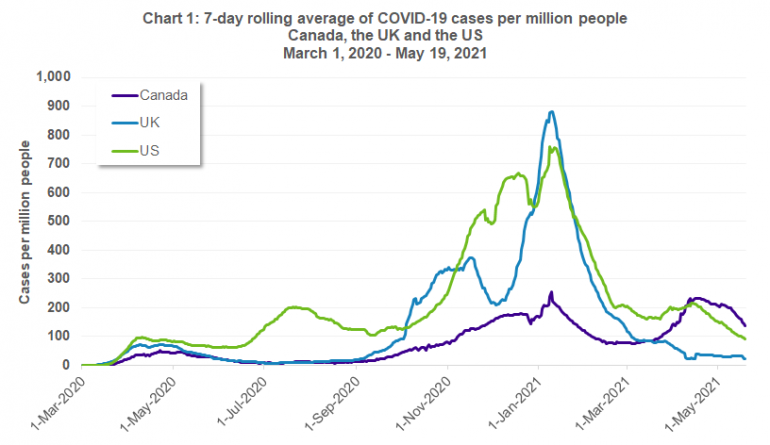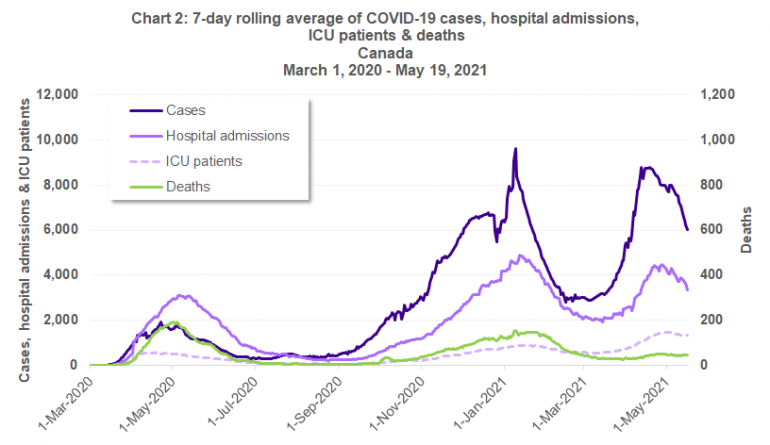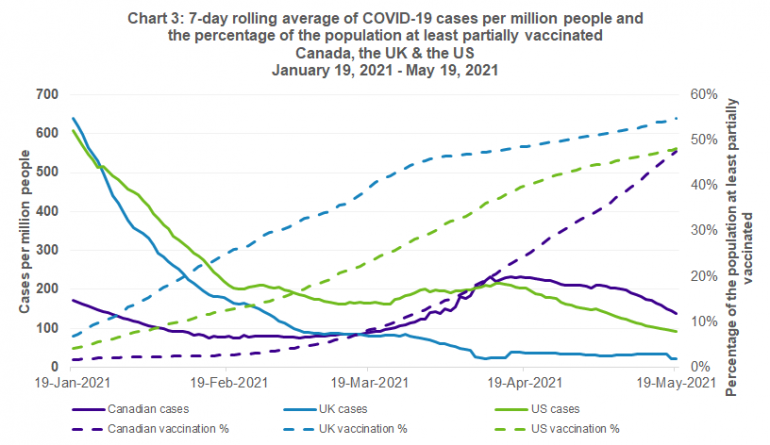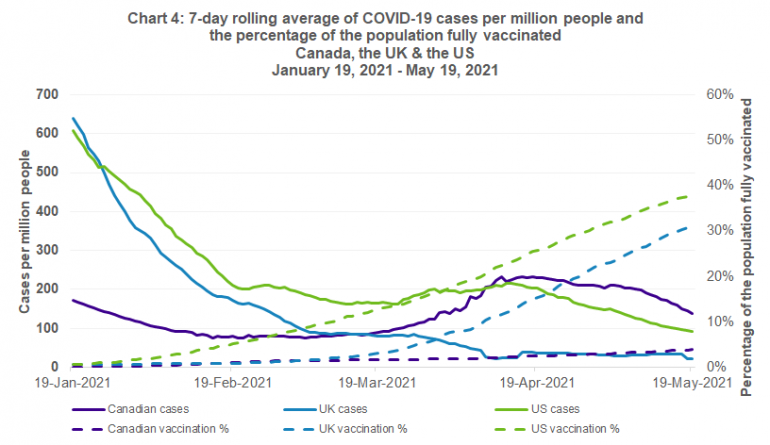The COVID-19 pandemic continues to have a devastating impact on mortality worldwide, making it an important research area for the Club Vita team. In this article we compare the current picture of the pandemic in Canada to the United Kingdom (UK) and the United States (US). We explore this in the context of the waves of the virus, the impact of vaccinations and the unknowns that could change the current outlook.
In summary:
- Canada has experienced less severe waves than the UK and the US, however, has had the highest new cases per million people in April 2021 amongst the three countries.
- Canada’s deaths due to COVID-19 in the third wave have been lower than previous waves but the level of hospitalizations remains a significant concern, and could have long-term effects on the healthcare system.
- Mass vaccinations in the UK and the US may have contributed to the decline in the spread of the COVID-19 virus, however slowing demand and supply, as well as new variants which may be less responsive to vaccines, present additional challenges.
The relative level of daily new cases in Canada is higher than the US and UK for the first time since the start of the pandemic
Chart 1 below shows the progression of the 7-day rolling average of COVID-19 cases and highlights the “waves” of the pandemic in Canada, the UK, and the US. A “wave” can be classified as a period of sustained increases in daily new COVID-19 cases followed by a period of sustained decreases.

Source: Official data collected from Our World in Data https://ourworldindata.org/
At the onset of the pandemic, all three countries saw national cases per million people rising in a similar trend, although at varying levels and with some notable differences between different regions within each country (e.g., Montreal and Vancouver). The true number of cases during this period was very likely to be understated as all countries struggled at the beginning of the pandemic to keep up with the demand for testing. Trends diverged after May 2020: while Canada and the UK saw a significant “cooling” of new cases in the summer months of 2020, the US experienced their second wave and saw new cases peak in July.
Both the UK and the US experienced significant waves in the latter part of 2020 and early in 2021 but have since seen a reduction in daily new cases ending their second and third waves respectively. Canada also experienced a second wave at the turn of the year, but entered its third wave after a short period of reduction in the number of new cases, and in April had cases per million people exceeding that of the UK and the US for the first time since the start of the pandemic.
Canada’s third wave is marked by increased hospitalizations
Canada’s third wave has seen total hospitalizations surpassing first wave levels and similar to second wave levels, and the number of patients being treated in intensive care units (ICUs) reaching a record high since the start of the pandemic. The strained ICU levels during the third wave highlight how COVID-19 continues to pose significant new challenges.
Chart 2 illustrates new COVID-19 cases and deaths alongside hospitalization figures. While we have seen new cases and hospitalizations increase at an alarming rate, fortunately deaths are not climbing at the same pace. Daily new cases and hospital admissions in the third wave are relatively similar to the second wave, however patients in ICUs have almost doubled, while deaths have more than halved.

Source: Official data collected from Our World in Data https://ourworldindata.org/
The fact that deaths do not follow a similar trend as ICU patients could be attributed to the increase in the proportion of Canada’s younger population contracting the virus. The younger population has a lower COVID-19 mortality rate than the older population who made up the majority of those infected during the first wave. Another element could be that high-risk individuals were prioritized for vaccination leading to lower mortality rates as cases spiked.
The continuing strain on the healthcare system posed by COVID-19 has the potential to lengthen the delay of patients’ diagnosis and treatment and contribute to further burnout and increased absence of hospital staff. We will continue to monitor the collateral impact the pandemic has on the health system, as well as on other aspects of our lives. These elements could affect longevity expectations.
Canada’s third wave is still unfolding, and we are catching up on the vaccination front
Many factors come into play when comparing the current outlook of the pandemic in the three countries – such as vaccinations, restrictions in place, adherence to restrictions and new variants, as well as demographic profiles.
While it is complex to assess these factors, data is readily available on the vaccination campaigns in the three countries. Charts 3 and 4 show the 7-day rolling average of COVID-19 cases compared to the percentage of the population who has received at least one vaccine dose and the percentage of the population that is fully vaccinated.
Being the first country to approve a COVID-19 vaccine, the UK saw a steep increase in the administration of at least one vaccine dose before the pace of increase slowed in April 2021. This trend could persist temporarily as UK government officials are predicting slower vaccine distribution until the end of July. The US was also successful in achieving rapid vaccine distribution but is now seeing some slowing as demand reduces.
While the UK has administered at least one vaccine dose to a higher proportion of their population than the US, a higher proportion of the US population is fully vaccinated (as shown by Chart 4). This could be partly due to the two countries taking different approaches to the time interval between the first and second vaccine dose, as well as encountering different challenges in the production and distribution of the vaccine.
Though the UK and the US are further ahead, Canada has picked up the pace in vaccine distribution following supply challenges earlier in the year and now approximately 4% of the Canadian population has been fully vaccinated. Like the UK, Canada is taking the approach of getting the first dose into as many people as possible before administering the second dose.

Source: Official data collected from Our World in Data https://ourworldindata.org/

Source: Official data collected from Our World in Data https://ourworldindata.org/
Many questions remain
Given the trends shown in this article, some key questions regarding Canada’s continuing COVID-19 experience are:
- What is the impact of mass vaccination in the UK and the US in limiting the spread of the virus versus the infection levels experienced? While Canada’s vaccination levels are catching up, the prevalence of those that have had COVID-19 are much less than in the UK and the US.
- Will Canada face additional challenges with vaccine supply and will we see slowing vaccine demand like in the UK and the US?
- How have differences in lockdown restrictions imposed in Canada versus those in the UK and the US impacted the spread of COVID-19? And how will differences in the lifting of restrictions in Canada affect new cases going forward?
- How will different variants of concern affect different parts of Canada?
There are many unknowns and therefore Club Vita will continue to closely monitor and share insights related to how COVID-19 is impacting short term longevity as well as future longevity.





